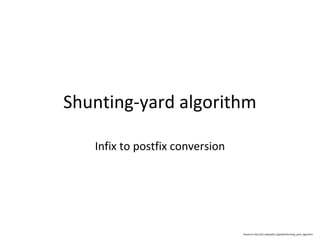More Related Content Similar to Shunting yard (7) More from grahamwell (20) 1. Shunting-yard algorithm
Infix to postfix conversion
Based on http://en.wikipedia.org/wiki/Shunting_yard_algorithm
2. 2 + (3 * (8 - 4)) = ?
How to evaluate this (or similar) formula?
TODO:
• rules should be visible and highlighted when a rule is applied
• an example containing operator precedence rules
3. 2 + (3 * (8 - 4)) = ?
Let’s play that the tokens are train cars and we are shunting the shunting yard.
2 + ( 3 * ( 8 - 4 ) )
4. 2 + (3 * (8 - 4)) = ?
The first car is a number, it goes straight through.
2 + ( 3 * ( 8 - 4 ) )
5. 2 + (3 * (8 - 4)) = ?
Next, the third track (the stack) is empty, we move the operator there.
2 + ( 3 * ( 8 - 4 ) )
6. 2 + (3 * (8 - 4)) = ?
Left parenthesis goes always down.
2 ( 3 * ( 8 - 4 ) )
+
7. 2 + (3 * (8 - 4)) = ?
Again, there is a number. It moves always straight to the left.
2 3 * ( 8 - 4 ) )
(
+
8. 2 + (3 * (8 - 4)) = ?
Next there is an operator, it goes down because the topmost car there is an parenthesis.
2 3 * ( 8 - 4 ) )
(
+
9. 2 + (3 * (8 - 4)) = ?
Again a left parenthesis, they go always to the stack.
2 3 ( 8 - 4 ) )
*
(
+
10. 2 + (3 * (8 - 4)) = ?
A number, straight to the left.
2 3 8 - 4 ) )
(
*
(
+
11. 2 + (3 * (8 - 4)) = ?
A number, straight to the left.
2 3 8 - 4 ) )
(
*
(
+
12. 2 + (3 * (8 - 4)) = ?
An operator, move it down.
2 3 8 - 4 ) )
(
*
(
+
13. 2 + (3 * (8 - 4)) = ?
A number, to the left, as always.
2 3 8 4 ) )
-
(
*
(
+
14. 2 + (3 * (8 - 4)) = ?
A right parenthesis. Now we move the cars from the bottom until there is left
parenthesis.
2 3 8 4 ) )
-
(
*
(
+
15. 2 + (3 * (8 - 4)) = ?
The pair of the parenthesis just disappear.
2 3 8 4 - ) )
(
*
(
+
16. 2 + (3 * (8 - 4)) = ?
Again, we pop out the items until there is a left parenthesis.
2 3 8 4 - )
*
(
+
17. 2 + (3 * (8 - 4)) = ?
A pair of parenthesis disappear.
2 3 8 4 - * )
(
+
18. 2 + (3 * (8 - 4)) = ?
No more cars on the right side, so we move the cars from the bottom to the left.
2 3 8 4 - *
+
19. 2 + (3 * (8 - 4)) = ?
Now the transformation is done, how to evaluate it?
2 3 8 4 - * +
20. 2 + (3 * (8 - 4)) = ?
Move the cars back to the right side.
2 3 8 4 - * +
21. 2 + (3 * (8 - 4)) = ?
Move the cars back to the right side.
2 3 8 4 - * +
22. 2 + (3 * (8 - 4)) = ?
Move the numbers to the down until we find an operator.
2 3 8 4 - * +
23. 2 + (3 * (8 - 4)) = ?
When operator is found, place it to the middle so that it is between two numbers.
- * +
4
8
3
2
24. 2 + (3 * (8 - 4)) = ?
Do the calculation and put the result back to down.
8 - 4 * +
3
2
25. 2 + (3 * (8 - 4)) = ?
Do the calculation and put the result back to down.
4 * +
3
2
26. 2 + (3 * (8 - 4)) = ?
Again, operator to the middle, between the two upmost numbers.
* +
4
3
2
27. 2 + (3 * (8 - 4)) = ?
Calculate the expression and put the result back to the down.
3 * 4 +
2
28. 2 + (3 * (8 - 4)) = ?
Calculate the expression and put the result back to the down.
12 +
2
29. 2 + (3 * (8 - 4)) = ?
And the last operator, it is handled in the same way.
+
12
2
30. 2 + (3 * (8 - 4)) = ?
Calculate the result and that’s it!
2 + 12
31. 2 + (3 * (8 - 4)) = 14
Calculate the result and that’s it!
14
